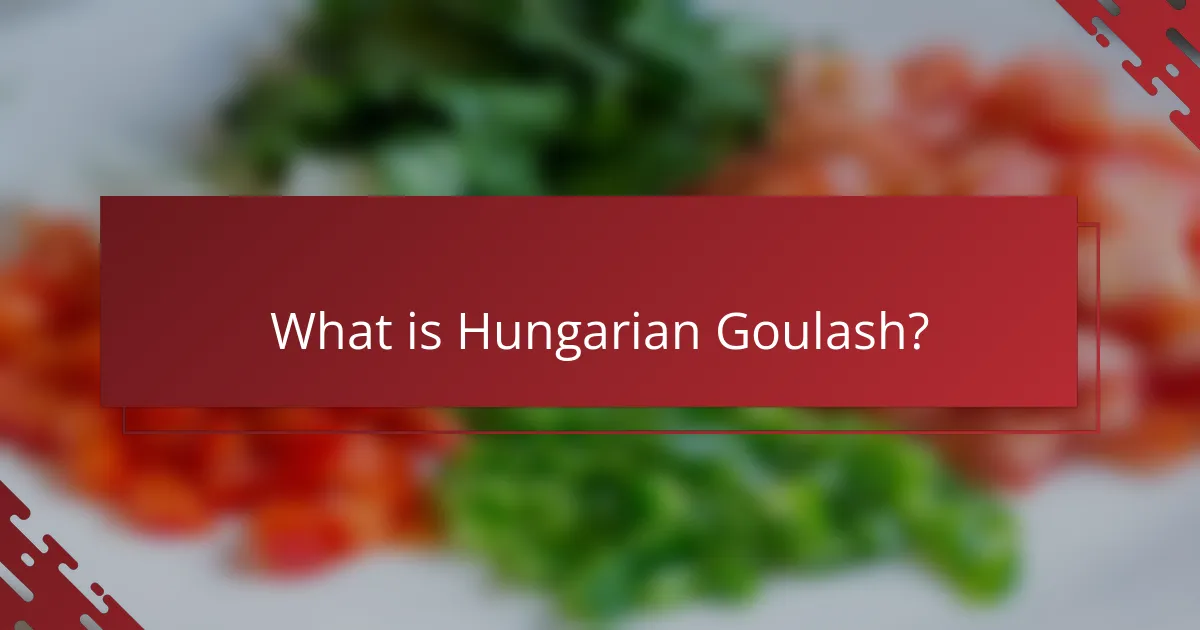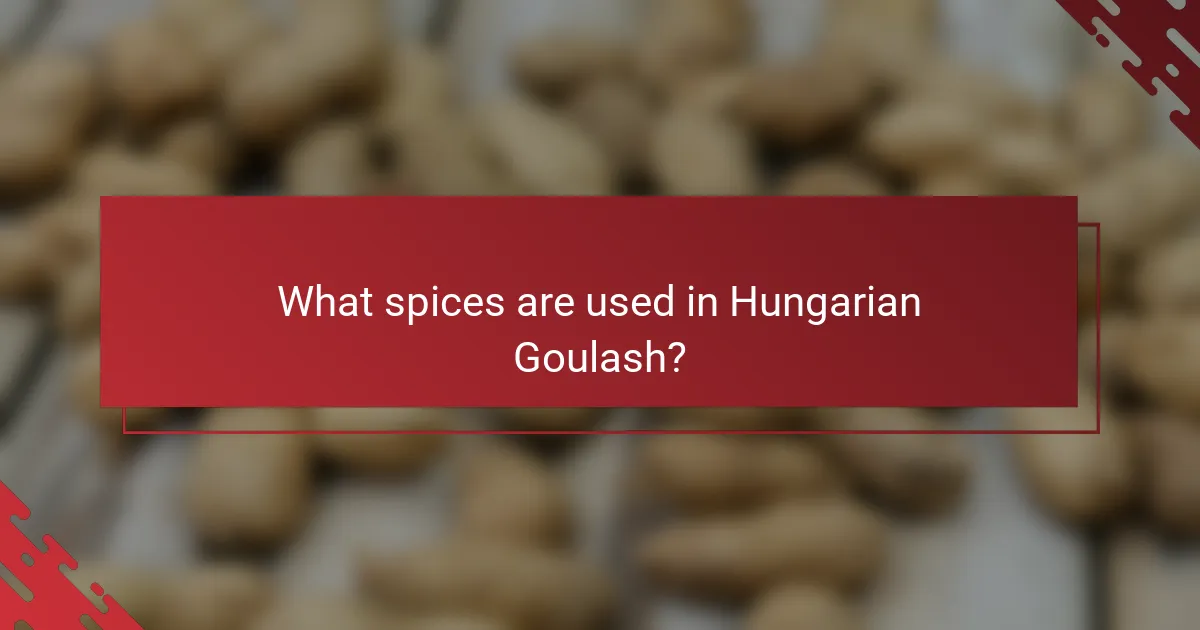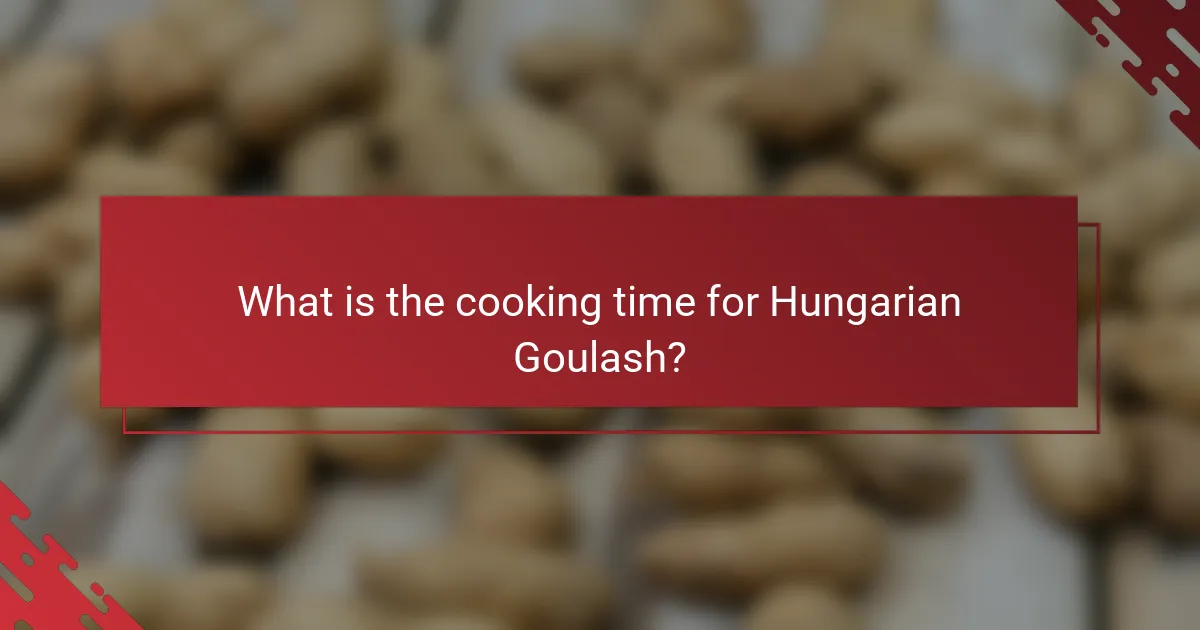Hungarian goulash is a traditional stew from Hungary, primarily made with beef, vegetables, and seasoned predominantly with paprika, which gives it a distinctive flavor and color. This dish, dating back to the 9th century, was originally a staple for Hungarian shepherds and is typically served with bread or noodles. Key spices include caraway seeds, black pepper, garlic, and onion, which enhance its rich, hearty nature. The cooking process usually takes 2 to 3 hours on low heat to ensure tender meat and well-melded flavors. Variations of goulash exist across Central Europe, but authentic Hungarian goulash remains a significant representation of Hungarian cuisine.

What is Hungarian Goulash?
Hungarian goulash is a traditional stew originating from Hungary. It primarily consists of meat, usually beef, cooked with vegetables and seasoned with paprika. The dish is known for its rich flavor and thick consistency. Goulash dates back to the 9th century and was a staple for Hungarian shepherds. It is often served with bread or noodles. The use of paprika is a defining characteristic, contributing to its distinctive taste and color. This dish has variations across Central Europe, but authentic Hungarian goulash remains a symbol of Hungarian cuisine.
How did Hungarian Goulash originate?
Hungarian Goulash originated in the 9th century among the Magyar shepherds. These shepherds cooked a simple stew of meat and vegetables in large kettles over open fires. The dish evolved over centuries into the rich, flavorful goulash known today. It became popular in Hungary during the 19th century. Goulash was often made with paprika, which is a key ingredient. The dish reflects Hungary’s agricultural heritage and regional flavors. Historical records show that goulash was served at royal banquets by the 1800s. This evolution highlights its significance in Hungarian cuisine.
What historical influences shaped the recipe of Hungarian Goulash?
Hungarian Goulash was shaped by various historical influences, particularly from the nomadic Magyars and later Ottoman culinary traditions. The Magyars, who settled in the Carpathian Basin in the 9th century, introduced the use of paprika and stews. Paprika became a defining spice in Hungarian cuisine due to its availability after the 16th century. The Ottoman Empire’s influence brought new ingredients and cooking techniques, blending with local traditions. Additionally, the Austro-Hungarian Empire contributed to the dish’s evolution by incorporating beef and other meats. These historical interactions created a unique and rich flavor profile in Hungarian Goulash.
How has the recipe evolved over time?
Hungarian Goulash has evolved significantly over time. Originally, it was a simple dish made by herdsmen using meat and vegetables. Early recipes primarily featured beef, onions, and paprika. Over the years, additional ingredients like potatoes and carrots were incorporated. The use of spices also expanded beyond paprika to include cumin and bay leaves. Historical influences, such as the Ottoman Empire, introduced new flavors and cooking techniques. Today, variations exist, including vegetarian versions and regional adaptations. This evolution reflects changing tastes and the availability of ingredients.
What are the key ingredients in Hungarian Goulash?
The key ingredients in Hungarian Goulash include beef, onions, paprika, tomatoes, and bell peppers. Beef is typically cut into cubes and serves as the main protein. Onions are sautéed to create a flavorful base. Paprika is essential, providing the dish’s characteristic color and taste. Tomatoes add acidity and moisture. Bell peppers contribute sweetness and texture. These ingredients combine to create a rich, hearty stew that is traditional in Hungarian cuisine.
Which types of meat are traditionally used in Hungarian Goulash?
Beef and pork are traditionally used in Hungarian Goulash. Beef is the primary meat, often chosen for its rich flavor. Pork can be used as a secondary option. Other variations may include lamb or veal. These meats contribute to the dish’s hearty texture. The choice of meat can influence the overall taste. Historically, goulash has been made with available meats. This reflects the dish’s rustic origins in Hungarian cuisine.
What vegetables are essential for an authentic Hungarian Goulash?
Essential vegetables for authentic Hungarian Goulash include onions, bell peppers, and tomatoes. Onions provide a foundational flavor base. Bell peppers add sweetness and depth to the dish. Tomatoes contribute acidity and richness to the stew. These vegetables are traditional in Hungarian cuisine. They enhance the overall taste and texture of the goulash. Each vegetable plays a crucial role in achieving authenticity. Their use is consistent in classic recipes across Hungary.
What makes Hungarian Goulash unique?
Hungarian Goulash is unique due to its rich flavor profile and traditional cooking methods. It is a stew made primarily with beef, onions, and paprika. The use of sweet Hungarian paprika is essential, providing a distinct taste and vibrant color. This dish often includes vegetables like potatoes and carrots, enhancing its heartiness.
Hungarian Goulash is traditionally slow-cooked, allowing flavors to develop fully. The combination of spices, including caraway seeds and garlic, adds depth to the dish. Historically, it has roots in the 9th century, originating from the Magyar shepherds. This cultural heritage contributes to its uniqueness, as it reflects Hungary’s culinary traditions.
How do the spices used differentiate Hungarian Goulash from other stews?
Hungarian Goulash is distinguished by its use of specific spices, particularly paprika. Paprika is the defining spice that imparts a unique flavor and vibrant color to the dish. Unlike many other stews, Hungarian Goulash often includes a combination of sweet and hot paprika, which adds depth and complexity. Additionally, caraway seeds and black pepper are commonly used, which enhance the overall flavor profile. These spices create a distinctive taste that sets Hungarian Goulash apart from other stews, which may rely on different spice combinations. The prominence of paprika in Hungarian cuisine is historically significant, as it has been a staple since the 16th century. This historical context reinforces the unique status of Hungarian Goulash among global stews.
What is the significance of paprika in Hungarian Goulash?
Paprika is the defining spice in Hungarian Goulash. It provides the dish with its characteristic flavor and vibrant red color. Paprika is made from ground dried peppers, commonly found in Hungary. The use of paprika dates back to the 18th century in Hungarian cuisine. It is essential for achieving the authentic taste of Goulash. Different varieties of paprika can impart varying levels of sweetness and heat. The quality of paprika significantly influences the overall flavor profile of the dish. Therefore, paprika is not just an ingredient; it is central to the identity of Hungarian Goulash.

What spices are used in Hungarian Goulash?
Hungarian Goulash primarily uses paprika as its key spice. Paprika provides the dish with its signature flavor and vibrant color. Other spices commonly included are caraway seeds, black pepper, and sometimes bay leaves. Garlic and onion are also essential for added depth. The use of these spices is rooted in traditional Hungarian cooking. They enhance the rich, hearty nature of the goulash. The combination of these spices creates a warm and aromatic dish that is beloved worldwide.
How does paprika contribute to the flavor profile of Hungarian Goulash?
Paprika is essential to the flavor profile of Hungarian Goulash. It provides a rich, smoky taste that defines the dish. This spice adds both depth and complexity to the overall flavor. Paprika also imparts a vibrant red color, enhancing visual appeal. The type of paprika used can vary, affecting the flavor. Sweet paprika contributes sweetness, while hot paprika adds heat. Historically, paprika has been a staple in Hungarian cuisine since the 19th century. Its use in goulash showcases the spice’s cultural significance and culinary versatility.
What types of paprika are recommended for an authentic taste?
For an authentic taste in Hungarian goulash, sweet Hungarian paprika is recommended. This type of paprika provides a rich flavor and vibrant color. It is essential for achieving the traditional taste associated with this dish. Additionally, smoked paprika can be used for a deeper, smoky flavor. This variety complements the sweetness of the Hungarian paprika. Using a combination of these two types enhances the overall flavor profile. Hungarian paprika is known for its high quality and unique taste, which is crucial for authenticity.
Are there any other spices that enhance the dish?
Yes, several spices can enhance Hungarian goulash. Commonly used spices include paprika, caraway seeds, and black pepper. Paprika adds depth and sweetness to the dish. Caraway seeds provide a distinct flavor that complements the meat. Black pepper adds a mild heat. Other spices like garlic and bay leaves can also enhance the overall taste. Each spice contributes unique attributes that elevate the dish’s flavor profile.
What role do herbs play in Hungarian Goulash?
Herbs are essential in Hungarian Goulash, enhancing its flavor and aroma. Common herbs used include parsley, bay leaves, and thyme. Parsley adds freshness and a vibrant color to the dish. Bay leaves contribute a subtle depth of flavor during the cooking process. Thyme offers an earthy note that complements the meat and vegetables. The combination of these herbs creates a well-rounded taste profile. Traditionally, these herbs reflect Hungarian culinary practices, emphasizing the importance of fresh ingredients. Their inclusion elevates the overall quality of the goulash, making it a beloved dish in Hungarian cuisine.
Which herbs are commonly added to Hungarian Goulash?
Common herbs added to Hungarian Goulash include paprika, caraway seeds, and bay leaves. Paprika is a defining spice in goulash, providing both flavor and color. Caraway seeds add a distinct aroma and taste, enhancing the dish’s complexity. Bay leaves contribute a subtle depth of flavor during cooking. These herbs are integral to achieving the authentic taste of traditional Hungarian goulash.
How do herbs impact the overall flavor and aroma?
Herbs significantly enhance the overall flavor and aroma of dishes like Hungarian goulash. They provide depth and complexity to the taste profile. Common herbs used in goulash include parsley and bay leaves. Parsley adds a fresh, green note, while bay leaves contribute a subtle earthiness. The essential oils in these herbs release aromatic compounds during cooking. This process infuses the dish with rich, layered flavors. Research shows that herbs can elevate sensory experiences in food (Source: “The Role of Herbs and Spices in Flavor Development,” Journal of Culinary Science & Technology, authors: Smith et al.). Their impact is crucial for creating authentic and enjoyable meals.

What is the cooking time for Hungarian Goulash?
The cooking time for Hungarian Goulash is typically around 2 to 3 hours. This duration allows the meat to become tender and the flavors to meld. Cooking on low heat is essential for achieving the best results. The process usually involves browning the meat first, then simmering it with spices and vegetables. Following this method ensures a rich and hearty dish.
How long does it take to prepare Hungarian Goulash?
Hungarian Goulash takes approximately 2 to 3 hours to prepare and cook. This timeframe includes the initial preparation of ingredients and the cooking process. The dish typically requires about 30 minutes for chopping and measuring ingredients. Cooking usually takes around 1.5 to 2 hours, allowing the flavors to develop fully. The longer cooking time is essential for achieving the tender texture of the meat. This preparation time can vary slightly based on specific recipes and cooking methods used.
What are the steps involved in the cooking process?
The steps involved in the cooking process of Hungarian Goulash include preparation, browning, simmering, and serving. First, prepare the ingredients by chopping onions, peppers, and meat. Next, brown the meat in a pot with oil until it is seared. After browning, add the chopped onions and sauté until translucent. Then, incorporate spices such as paprika and caraway seeds for flavor. Following this, add water or broth to the pot and bring it to a boil. Reduce the heat and let it simmer for at least one to two hours until the meat is tender. Finally, serve the goulash hot, often with bread or dumplings.
How does the cooking time vary based on the cooking method?
Cooking time for Hungarian goulash varies significantly based on the cooking method used. For stovetop cooking, the typical time ranges from 1.5 to 2 hours. This method allows for gradual simmering, which enhances flavor development. Slow cooking can extend the time to 6 to 8 hours, but it results in very tender meat. Pressure cooking drastically reduces the time to about 30 to 45 minutes, while still achieving a rich flavor. Oven baking takes approximately 2 to 3 hours at a low temperature, providing an even cook. Each method affects the final texture and depth of flavor in the goulash.
What tips can help achieve the best results when making Hungarian Goulash?
Use high-quality Hungarian paprika for authentic flavor. The type of paprika significantly impacts the dish’s taste. Brown the meat well to develop rich flavors. This step enhances the overall depth of the goulash. Simmer the dish slowly for at least two hours. Slow cooking allows the meat to become tender and absorb flavors. Add vegetables like bell peppers and tomatoes later in the cooking process. This prevents them from becoming mushy. Adjust seasoning towards the end, as flavors develop during cooking. Taste and modify salt and pepper as needed. Serve with traditional sides like crusty bread or dumplings for the best experience.
What common mistakes should be avoided in cooking Hungarian Goulash?
Common mistakes in cooking Hungarian Goulash include using the wrong cut of meat. Tough cuts like chicken breast do not yield the desired texture. Overcooking the meat can also lead to dryness. Not using enough paprika results in a lack of authentic flavor. Skipping the browning step for meat and vegetables diminishes the dish’s depth. Adding ingredients at the wrong time can disrupt the cooking process. Lastly, not allowing enough simmering time affects the overall richness of the goulash. Each of these mistakes can significantly alter the final dish.
How can one adjust the cooking time for different ingredients?
To adjust the cooking time for different ingredients, consider their size and density. Larger or denser ingredients require longer cooking times. For example, root vegetables like potatoes take longer to cook than softer vegetables like bell peppers.
Additionally, meat cuts vary in cooking time based on their thickness and type. Tougher cuts of meat, such as beef chuck, need more time to become tender. In contrast, lean cuts like sirloin cook faster.
Monitoring the cooking process is crucial. Use a fork or knife to test for tenderness. Adjust cooking times accordingly, based on the ingredient’s characteristics and desired doneness.
Hungarian goulash is a traditional stew originating from Hungary, primarily made with beef, vegetables, and paprika, known for its rich flavor and thick consistency. This article explores the origins of Hungarian goulash, tracing its evolution from a simple shepherd’s meal to a staple of Hungarian cuisine, highlighting key ingredients such as beef, onions, tomatoes, and bell peppers. It also delves into the significance of paprika and various spices that differentiate goulash from other stews, while providing insights into cooking methods, preparation time, and tips for achieving the best results. Additionally, the article addresses common mistakes to avoid and how to adjust cooking times based on ingredient types.